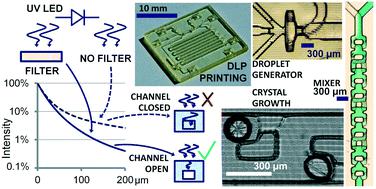Our official English website, www.x-mol.net, welcomes your
feedback! (Note: you will need to create a separate account there.)
Accurate and rapid 3D printing of microfluidic devices using wavelength selection on a DLP printer
Lab on a Chip ( IF 6.1 ) Pub Date : 2020-10-13 , DOI: 10.1039/d0lc00767f Peter J. E. M. van der Linden 1, 2, 3, 4 , Anton M. Popov 3, 4, 5 , Diego Pontoni 1, 2, 3, 4
Lab on a Chip ( IF 6.1 ) Pub Date : 2020-10-13 , DOI: 10.1039/d0lc00767f Peter J. E. M. van der Linden 1, 2, 3, 4 , Anton M. Popov 3, 4, 5 , Diego Pontoni 1, 2, 3, 4
Affiliation

|
The use of microfluidics on synchrotron X-ray beamlines represents an advanced sample preparation and delivery platform for state-of-the-art X-ray characterization of micro-samples. The recent developments of 3D printing technologies have opened possibilities for rapid fabrication of complex microfluidic devices. One of the major challenges in 3D printing of microfluidic devices using a digital light processing (DLP) desktop printer is that the static liquid resin trapped in the channels, once the “ceiling” is printed, still receives small doses of light through the subsequently printed layers. This easily triggers partial polymerisation of the resin which impedes its flushing out of the channels after completion of the printing session. We show here that it is possible to gain better control over the resin polymerisation and improve the quality of the microfluidic devices by efficiently reducing the penetration depth of the UV LED light through wavelength selection combined with a careful choice of absorber and photo-initiator materials. We produced and tested several structures using a slightly modified desktop printer at 385 nm wavelength with 37 × 37 μm2 pixel resolution at a printed layer thickness of 25 μm. The structures include particle filters, mixers, droplet generators and droplet storage traps with features below 100 μm. We demonstrate crystallisation of model inorganic and organic compounds in trapped droplets and assess the feasibility of in-device X-ray diffraction experiments. This research opens the path for the use of 3D printed microfluidic devices on X-ray beamlines.
中文翻译:

使用DLP打印机上的波长选择来准确,快速地对微流体设备进行3D打印
在同步加速器X射线束线上使用微流体技术代表了先进的样品制备和输送平台,可用于微样品的最新X射线表征。3D打印技术的最新发展为快速制造复杂的微流体设备打开了可能性。使用数字光处理(DLP)台式打印机进行微流体设备3D打印的主要挑战之一是,一旦“天花板”被打印,滞留在通道中的静态液态树脂仍然会通过随后的打印接收少量的光层。这很容易触发树脂的部分聚合,从而阻止其在印刷过程完成后从通道中冲出。我们在这里表明,通过有效地通过选择波长和结合精心选择吸收剂和光引发剂材料来降低UV LED光的穿透深度,可以更好地控制树脂聚合并改善微流体装置的质量。我们使用经过稍微修改的台式打印机在385 nm波长和37×37μm下生产并测试了几种结构印刷层厚度为25μm时为2像素分辨率。这些结构包括特征小于100μm的颗粒过滤器,混合器,液滴发生器和液滴存储阱。我们展示了捕获的液滴中模型无机和有机化合物的结晶,并评估了装置内X射线衍射实验的可行性。这项研究为在X射线束线上使用3D打印微流体设备开辟了道路。
更新日期:2020-11-03
中文翻译:

使用DLP打印机上的波长选择来准确,快速地对微流体设备进行3D打印
在同步加速器X射线束线上使用微流体技术代表了先进的样品制备和输送平台,可用于微样品的最新X射线表征。3D打印技术的最新发展为快速制造复杂的微流体设备打开了可能性。使用数字光处理(DLP)台式打印机进行微流体设备3D打印的主要挑战之一是,一旦“天花板”被打印,滞留在通道中的静态液态树脂仍然会通过随后的打印接收少量的光层。这很容易触发树脂的部分聚合,从而阻止其在印刷过程完成后从通道中冲出。我们在这里表明,通过有效地通过选择波长和结合精心选择吸收剂和光引发剂材料来降低UV LED光的穿透深度,可以更好地控制树脂聚合并改善微流体装置的质量。我们使用经过稍微修改的台式打印机在385 nm波长和37×37μm下生产并测试了几种结构印刷层厚度为25μm时为2像素分辨率。这些结构包括特征小于100μm的颗粒过滤器,混合器,液滴发生器和液滴存储阱。我们展示了捕获的液滴中模型无机和有机化合物的结晶,并评估了装置内X射线衍射实验的可行性。这项研究为在X射线束线上使用3D打印微流体设备开辟了道路。











































 京公网安备 11010802027423号
京公网安备 11010802027423号